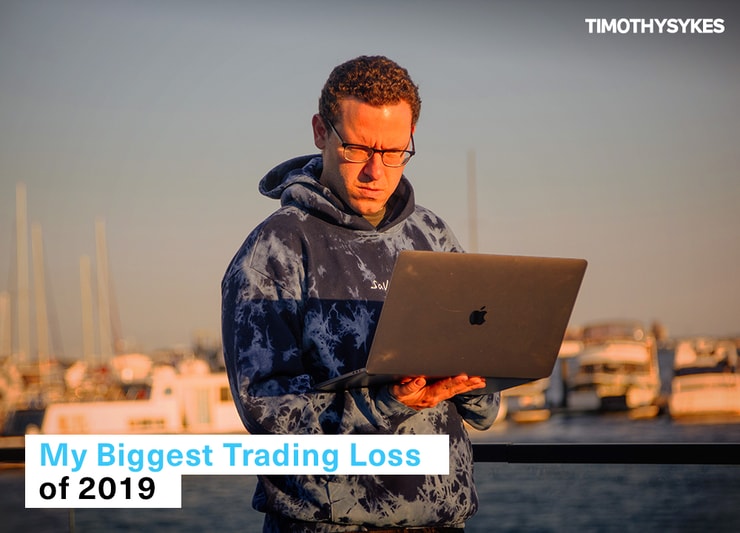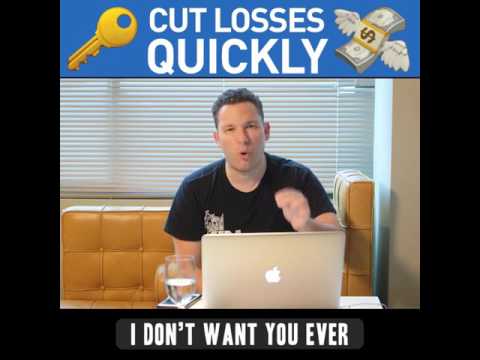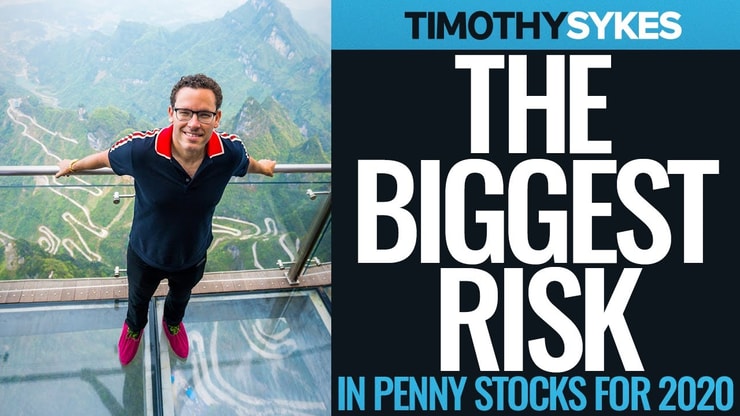Recently, I had my biggest loss of 2019. I have my share of losses. But this one was different — nearly three times larger than my next biggest loss.
What happened? In short, I was traveling, picked the wrong ticker, and had a bad connection. Next thing I know, I’m out nearly $2,000.
And it all happened while I was giving a live Trading Challenge webinar. My students had a riot — they loved it! Not because they like to see me lose (well, maybe some of them do) but because it shows them I’m real.
In a world of fakes, I’m the real deal. My trades are real. Even my mistakes are real.
Lots of ‘gurus’ on the internet love sharing a screenshot of $5,000, $10,000, or even $20,000 profits. But they never show any losses. They’re scam artists. They hide their losses, which are likely bigger than their wins.
No one wins 100% of the time. NO ONE. That’s not what trading is about, anyway.
Table of Contents
Big Losses Suck
To be perfectly honest with you, I was frustrated by this trade. So many things went wrong.
First, I was watching three tickers — ASLN, SORL, and CANF. I picked CANF, and it was the only one to fail. I can handle that. I understand that sometimes trades just don’t go as planned. That’s when you have to follow rule #1 and cut losses quickly.
That’s exactly what I wanted to do … But my internet connection was spotty and my orders weren’t getting through to my broker. That compounded the loss. If my order had been executed quickly, I might’ve been out for an $800 loss. Still a loss but not as bad.
Here’s my comment from when I entered the trade on November 29:
Bought this big percent winner with positive news, goal is to sell into speculative Friday morning spike, low 4s ideally
And here’s what I posted as I finally exited:
Finally got executed, wasn’t able to cut losses quickly, will call Etrade later, but nasty loss, this is what happens when you break rule #1, even if its inadvertently
Some things are beyond your control. On this trade, I really wanted to follow rule #1 and cut losses quickly. But I had a crappy connection and just couldn’t.
Does it suck? Sure. But I’m not dwelling on it. I’m accepting my loss and moving on to the next. Just like I did with ASTC a few weeks ago (read my full review of that trade here). Ideally, you get out as soon as the trade goes against you.
Living the Laptop Lifestyle
A bad internet connection hurt me this time, but it’s actually helped me in the past.
You can check out one instance in my book, “An American Hedge Fund.” I was studying abroad and trading from a ship. I had a huge short position and was trying to cover it when the internet went down.
I raced desperately around the ship like an idiot. I begged for a phone so I could call my broker. As soon as I got a phone, that connection went down. I finally got back online and covered my position — for a bigger profit. (Get the book here to read the full story.)
I got lucky that time. But sometimes, things are beyond your control.
When you trade with iffy connections, it’s risky. You may luck out and score a big win … Or you can lose big and fast. That’s why it’s so important to manage your risk. But really…
I’m OK With Paying a Freedom Tax
I could stay in New York City with an ultra-fast internet connection and never have this problem again.
People say, “Tim, if you did that, you’d make money hand over fist! Why don’t you?”
The answer’s simple: I don’t want to live that life. I don’t want to stay in one place. I love to travel. I love my freedom. And I love giving back.
Trading like I’m retired allows me to do so much more than just make money. The work I do through my charity Karmagawa has changed my life. I have the freedom to go anywhere I want whenever I want.
So sometimes I end up taking a bigger loss than if I stayed in one place with super stable Wi-Fi. Like I said, I’m OK with it. For me, it’s completely worth it. I’ll call the nearly $2,000 loss on this trade a freedom tax. And I’ll absolutely pay $1,000 per year to live this life.
Life is short — focus on living the life you want.
Are you willing to make sacrifices for what you really want in life? If so, maybe you’ve got what it takes to be one of my Trading Challenge students. Apply now to see if you make the cut.
If you plan to start trading, you need to find a mentor. Whatever you do, make sure you…
Avoid Fake Gurus
You find them on Twitter and Youtube. The ‘gurus’ who claim they can teach you to trade in three easy steps or sell you ‘can’t lose’ alerts.
These scam artists lure you in with screenshots of big wins. Individual screenshots mean nothing. Anyone can get lucky and have a big win. And anyone can photoshop “results.”
It takes so much more to be consistent over time. If a trading ‘guru’ doesn’t show you wins and losses, you aren’t seeing the whole picture.
The only way to know if someone is legit is to see ALL their trades. If they aren’t willing to share the good, the bad, and the ugly, watch out.
How to Tell Educators from Scam Artists
I’ve been called a fake for years. You’re right to be suspicious of everyone in this industry, including me.
The good news? You don’t have to take my word for it.
Michael Goode** was my original hater and turned into my first millionaire student!
Here are a few comments from the live webinar as I tried to get out of the failing trade. I hate to lose as much as anyone. But this trade, despite the resulting loss, was ultimately a positive experience.
Check out these students who agree…
9:46 AM Petros_rok_nation: One of the best webinars I have been part of. Only because that execution bs. Good to hear your voice again, thanks Tim.
9:49 AM Peachtart: Anyone who doubts you are real…today’s webinar certainly proves it !!
9:50 AM KarolaCrawford: It’s proof that you’re the real thing!! Thanks for sharing, though I am sorry about your loss.
I share my story and my trades. My students are real, my process is real. Don’t ever trust anyone who won’t share ALL their trades with you. Great teachers will have successful students to show for it.
Check out https://t.co/OHqNrxjqI6 to see why I’m often labeled as a scam & let me explain why I’m NOT! $FB $TWTR
— Timothy Sykes (@timothysykes) February 24, 2019
More Breaking News
- Northern Dynasty Minerals Stock Rises on Positive EPA Settlement News
- RYTM Stocks in Spotlight: What’s Next?
- Bit Digital’s Bold Move: What Lies Ahead?
Why You Should Join Profit.ly Today
Profit.ly is a trade-tracking, idea-sharing, social media platform for traders and investors. You can upload all your trades and use the data to track your results over time.
People on Wall Street don’t use Profit.ly. The idea of sharing trades publicly isn’t popular with a lot of traditional traders. But if you want to make it in the long run, you have to find a way to hold yourself accountable. You need to track your trades to find what works and what doesn’t.
I was able to quickly figure out how this loss compared to others because I log every single trade. I’m fully transparent as a trader.
It is impossible to know if you’re improving if you don’t know where you’ve been. Join Profit.ly today and start tracking your trades. And always remember…
Losing Is a Part of Trading

2025 Millionaire Media, LLCIt’s been a while since I took a loss this big. I just reviewed my numbers for the past three years — about how long I’ve been trading with just a small account.
Using Profit.ly, I filtered my trades. I made $545,000 in profits after deducting all losses. That’s $182,000 per year. In the past three years, trading with a small account, I made more than most professionals. And I spent less time doing it.
So my $1,950 loss is a mere 0.36% of my gains over the past three years. That’s less than half a percent! So yeah, this particular trade went against me. But I’m not bankrupt.
My biggest loss of the year had a minimal impact on me. Virtually no impact on my overall profits. The biggest impact I faced was mental. I was completely frustrated by the situation.
So I stepped back to get some perspective.
Here’s a bit of trading advice: never trade when you’re hung up on your last trade. A huge part of trading is controlling your emotions. Check out Tim Grittani’s awesome trading psychology tips here.
Every trader must learn these two principles: control your emotions and keep your losses small. This is the process that I both use and teach.
The Dangers of Penny Stocks
Everyone from Wall Street to Main Street loves to hate on penny stocks. Meanwhile, I’ve been trading them for over 20 years and teaching others how to trade them for over 10 years.
Some of my top students have crossed the millionaire mark, like Michael Goode, Tim Gritanni, and Steven Dux.**
Over 90% of people lose money trading, but some manage to succeed. Any successful trader will tell you to find and stick to a specific trading strategy. Develop a process.
For all the ‘gurus’ out there who want to sell you ‘hot stock’ picks, ask them for the name of their last millionaire student or subscriber. Ask to see every trade.
You’ll never get rich following alerts — not even mine. I share my trades and alerts with you to show you the process. I make and lose money in real-time in front of my students.
You can learn to manage your risk if you’re willing to learn the process.
6 Real Dangers of Penny Stocks
Make no mistake, there are real dangers to trading — especially penny stocks. I teach my students to avoid them. Here are six ways trading penny stocks can go south:
- You don’t cut losses quickly. This can turn small losses into big losses.
- You fall in love with a stock. Always have an exit strategy.
- You blindly follow alerts. Develop and follow your own plan. Do your research. Don’t trust anyone else.
- You short low floats. Just don’t do it. It’s too risky.
- You trade with leverage. You can lose more than your entire account.
- You trade too big. Use proper risk/reward.
Understand Risk vs. Reward
Reviewing my trades on Profit.ly, I found a huge gap between my biggest winners and losers.
Looking at the past year, I had 13 trades that produced a profit of $1,950 or more. My biggest win was $4,092. That’s more than double my biggest loss.
My second biggest loss of the year was $745, and my third was $700. I’ve got 68 winning trades from the past year with a profit of over $700.
How? It’s all about risk vs reward. Keep your risk low and maximize your reward. Don’t risk $1 if the most you expect to gain is $1. Professional traders don’t go for coin flips. You risk $1 when you expect to gain $3, $5, or even $10.
That’s the basic concept behind the risk-reward ratio. I keep my ratio at 3:1 minimum. I prefer 4:1 and 5:1, and sometimes you can get 10:1 on the very best setups.
That’s why is important to only trade the best setups. Use my Trader Checklist to help you figure out if your setup is worth the risk.
Trade Like a Coward
Always follow rule #1: cut losses quickly.
It seems so simple, but it’s hard for most new traders. (Check out this post for common mistakes). Not cutting losses is a fast way to blow up.
Also, follow smart trading rules and learn to cope with your losses. They will happen. I’ve had some big losses in my 20+ years of trading. Now I trade scared.
My goal is to make more coward traders. I want you to be scared to take a big loss. Nothing can destroy your capital and mindset like a big loss. Learn to trade smarter and take small losses.
If you take a big loss, learn from it and do your best to prevent it from happening again. Remember, any trade can go against you at any time. Just like CANF did for me.
One trade will never make you rich, but one trade can bankrupt you. Educate yourself. Start with my no-cost YouTube videos, my FREE Penny Stock Course Intro, and these key trading rules.
Ready to really up your trading game? Apply for my Trading Challenge NOW.
[**Note that these results aren’t typical. These students put in the time and dedication and have exceptional skills and knowledge. Most traders lose money. Always remember trading is risky … never risk more than you can afford.]
I want to know what you think! Leave a comment below…












Leave a reply